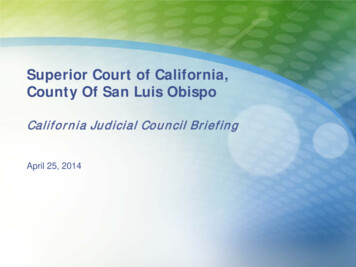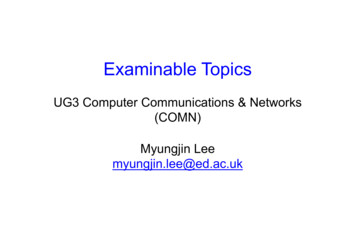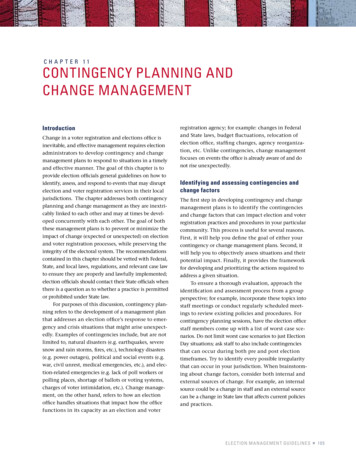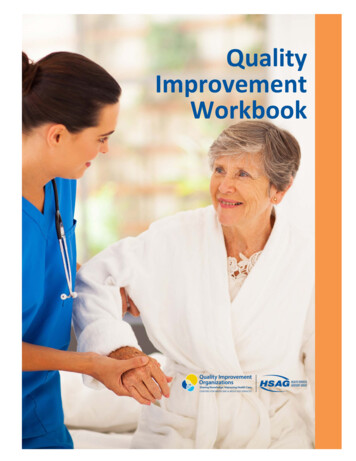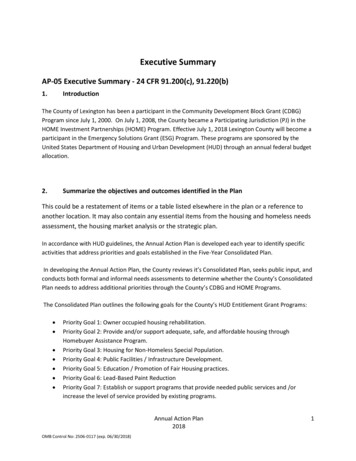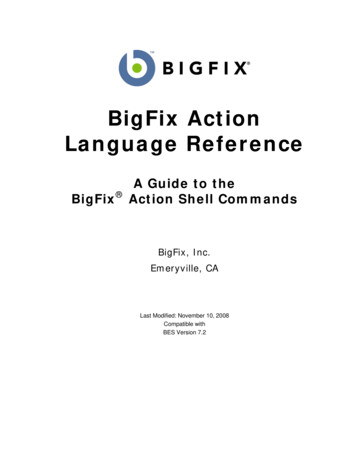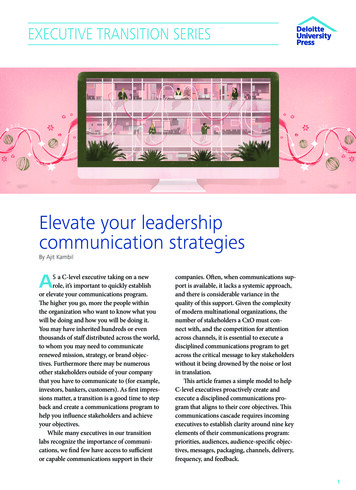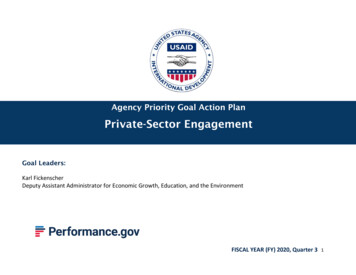
Transcription
Agency Priority Goal Action PlanPrivate-Sector EngagementGoal Leaders:Karl FickenscherDeputy Assistant Administrator for Economic Growth, Education, and the EnvironmentFISCAL YEAR (FY) 2020, Quarter 31
OverviewGoal StatementExpand engagement with the private sector to achieve greater development outcomes. By September 30, 2021, 100 percent ofUSAID Missions will have a Private-Sector Engagement (PSE) Plan in place that integrates country-specific PSE approaches intoprogramming and operations, and 90 percent of USAID Missions will demonstrate action taken in line with their PSE Plan.ChallengePrivate sources now represent nearly 90 percent of financial flows to developing countries, 1 and dwarf Official DevelopmentAssistance. The private sector creates nine out of ten jobs in the developing world 2 and provides an important pathway to selfreliance. On their own, donor agencies are unable to fulfill their goals for sustainable development. The public sector alone does nothave the resources to match the scale and complexity of the challenges that communities face on the Journey to Self-Reliance.OpportunitiesChanges in the global development context have increased the alignment of interests between the private sector anddevelopment actors. There is growing recognition within the private sector of the need for, and benefits of, investing in the developing world.Governments are expanding efforts to diversify their economies and connect with capital for investment. To capitalize on these opportunities and move closer to ending the need for assistance, USAID must increase and deepen ourcollaboration with the private sector. Barriers PSE requires a shift in the Agency’s corporateculture and mindsets, which takes time andrequires a robust and concerted strategy.PSE presents challenges with already-stretchedbandwidths.Perceived and real contracting impedimentsand risk-averse culture can discourageinnovation.Actions to Address Developing a repository of compelling PSE stories that illustrate thestrategic shift in PSE and how it is different from traditional approaches.Encouraging working groups to distribute the responsibility, including byincluding PSE in employees' work objectives.Offering training targeted at contracting and legal staff, increasingawareness of Agency’s Risk-Appetite Statement, and joining efforts withEffective Partnering and Procurement Reform.1The Index of Global Philanthropy and Remittances 2016, Hudson Institute, 2016, page 9.World Development Report 2013, World Bank 2013, page 7; and Jobs Study: Assessing Private-Sector Contributions to Job-Creation and Poverty-Reduction,January 2013, International Finance Corporation.22
Goal LeadershipUSAID's PSE TeamThe PSE Team (the future “PSE Hub”) is the Office of Private Capital and Microenterprise in the Bureau for Economic Growth,Education, and the Environment, and the Center for Transformational Partnerships in the U.S. Global Development Lab. The PSETeam is leading efforts to advance the implementation and institutionalization of USAID’s PSE Policy. Both units will become part ofthe new Bureau for Development, Democracy, and Innovation (DDI) when it becomes operational early in Fiscal Year (FY) 2021.The Vision for the PSE HubHoused in the forthcoming DDI Bureau, the future PSE Hub will support the Agency in advancing the use of market-basedapproaches to deliver development and humanitarian results across all sectors. The Hub will drive transformation in the Agency’sculture and operations to embrace greater collaboration with the private sector in achieving outcomes.The PSE Hub will coordinate USAID’s efforts to broaden our relationships with commercial entities and transform the way theAgency conceives of, designs, and delivers programs. This includes the development of USAID-specific frameworks for working andco-investing with private companies to create new tools; aligning incentives for staff; and bolstering processes to facilitate PSEthroughout the Agency’s program, from design to evaluation, and in every sector.The goals of the future PSE Hub include the following:1.2.3.Adopting more market-based solutions to development and humanitarian challenges;Seeking to address market failures proactively through the Agency’s programs in every sector; andIncreasing significantly innovation in and collaboration with private enterprise across USAID’s work.3
Goal Structure and StrategiesUSAID’s PSE Policy is an Agency-wide call to action to work hand-in-hand with the private sector to conceive, design, and deliver ourdevelopment and humanitarian programs across all sectors. USAID is building local capacities and institutions that bolster nationalself-reliance. To move the Agency closer to achieving our goal of ending the need for assistance, USAID is prioritizing sustainable,market-based solutions; the mobilization of private capital to expand the scale of development programs and their outcomes; andgreater collaboration with the private sector.The Agency Priority Goal (APG) on PSE will report on our progress made in implementing USAID’s PSE Policy along the threephases outlined below.By September 30, 2021.Initial Mandatesof the PSE PolicyMet (Compliance)PSE Integratedinto Operationsand ProgrammingPSE Policy is putinto Practice(Action)100 percent of USAIDMissions will have aPSE Plan in place that integratescountry-specific PSEapproaches intoprogramming andoperations and 90 percent ofUSAID Missions willdemonstrate actiontaken in line withtheir PSE Plan.Development ImpactExpand engagement withthe private sector toachieve greater, moresustainable,development outcomes.Enhanced ability forpartner countries4 tobe self-reliant4
Summary of Progress - Third Quarter (Q3) of FY 2020During the Third Quarter (Q3) of FY 2020, USAID continued to make progress in engaging the private sector and institutionalizing PSEas a key approach to delivering programming: As USAID Missions continue to develop their Country Development and Cooperation Strategies (CDCS), the PSE team hasreviewed and supported nearly 60 CDCSs to integrate PSE as a strategic approach in advancing countries on their Journeys toSelf-Reliance. USAID’s PSE Community of Practice has grown to 1,938 staff, and 410 staff have joined the PSE platform (PSE KnowledgeExchange) for peer-to-peer exchange of experiences and approaches. During Q3, members of the Community of Practiceshared 42 topics via the Knowledge-Exchange, which generated 114 posts. Top discussion topics included a thread on howcompanies are responding to COVID-19 and sharing experiences related to PSE Working Groups and Mission operations. To protect the health and safety of our staff during the pandemic of COVID-19, USAID cancelled training sessions planned forQ3 and scheduled the training sessions to resume in Q4. USAID’s PSE Team released the PSE Evidence Gap Map in accordance with the PSE Evidence and Learning Plan and theAgency’s Self-Reliance Learning Agenda (SRLA). The Evidence Gap Map is an online visual representation of existingdocumentation and evidence, which uses a matrix of USAID’s conceptualization of PSE. It compiles evidence in one placewith a number of filter and search features to facilitate the use of evidence. USAID’s PSE Actions Dashboard launched internally during Q3. Built in collaboration with Data Services in the Office of theChief Information Officer within in Bureau for Management, the PSE team reviewed the PSE Plans from 102 Operating Units(OUs) and identified and consolidated 200 actions into 47 standardized actions. Users can sort data by OU, region, sector,status, categories of actions, or actions. This powerful new tool allows our staff to gain insights and analyze how the Agencyis advancing PSE in our programming and operations Agency-wide. On May 28, 2020, an Agency-wide PSE quarterly call brought together more than 285 USAID staff from 28 Missions and 19Bureaus and Offices under the theme, “Shaping PSE during Crisis Response.” Experts from the Bureaus of HumanitarianAssistance and Global Health, and the Development-Informatics team in the Center for Digital Development within the U.S.Global Development Lab reviewed lessons learned, and PSE Points of Contact in Kenya and India shared how their Missionsare adjusting and responding to COVID-19 in collaboration with the private sector.5
Field SpotlightsDelivering Vital, Accurate COVID-19 Information to Millions Through Mobile Phones in NigeriaAcross sub-Saharan Africa, mobile phones are changing how people farm, bank, and gain access to health care. With the outbreak ofthe pandemic of COVID-19, mobile phones are proving critical to controlling the spread of the virus. In the Federal Republic ofNigeria, the number of COVID-19 cases has reached more than 17,000 in four months—an alarming rate of transmission in Africa’smost populous country, home to 200 million people. To stem the spread of new infections, USAID/Nigeria joined forces withtelecommunications provider Airtel to deliver vital information to millions of citizens on how to protect themselves from COVID-19.As cases of COVID-19 emerged, USAID/Nigeria rapidly responded by supporting the Government of Nigeria to launch a nationwiderisk-communications campaign. Airtel uses the “3-2-1 service” to provide its 51 million Nigerian subscribers with access to keymessages on COVID-19 in five major languages at no cost, and at their convenience. Working with USAID-funded partnerBreakthrough ACTION-Nigeria and the Nigeria Center for Disease Control (NCDC), Airtel is providing its infrastructure and airtime tomake key health information available for free.“The support from USAID has strengthened our capacity to respond to challenges of the outbreak, particularly in the area of riskmanagement communications,” said Dr. Chikwe Ihekweazu, NCDC’s Director-General.For Airtel, the benefit is clear—purchases of Airtel SIM cards have increased, and more people are recommending the service.“Airtel is excited to partner with USAID.and other stakeholders to create a nationwide platform that offers opportunities to enablemillions of Nigerians across various communities to lead better and healthier lives, especially during this period of the global COVID19 pandemic,” said Dr. Segun Ogunsanya, Chief Executive Officer and Managing Director of Airtel Nigeria.Regardless of a subscriber’s type of mobile phone, location, language, or literacy level, the Government of Nigeria can now instantlyreach millions of people through this partnership, which has helped NCDC rapidly develop, host, and disseminate messages onCOVID-19 to the public. Within two months of the outbreak, Airtel had placed calls to 15 million subscribers and sent out 32 milliontext messages, and nearly 190,000 people had called the 3-2-1 service to receive information about COVID-19. The estimated totalcost of the free airtime donated is at 455,000.By harnessing the power of mobile phones to reach people with critical and reliable information on COVID-19, USAID and Airtel aredispelling misinformation and increasing awareness for the adoption of preventive behaviors in Nigeria.6
Theory of Change7
Indicators and MilestonesKey MilestoneCompliance: 100 percent of USAID’s Missions, Bureaus, andIndependent Offices (M/B/IOs) have a designated Private-SectorEngagement (PSE) Point of Contact (POC).Milestone DueDateFirst Quarter(Q1) Fiscal Year(FY) 2020Cultural Shift: Launch the PSE Knowledge-Exchange, a listservQ1 FY 2020that enables the peer-to-peer exchange of best practices,crowdsourcing answers to questions, and the sharing ofopportunities with private firms.Compliance: 97 percent of Missions have a plan in place forSecond Quarterputting the PSE Policy into practice (submitted to the PSE Team).(Q2) FY 2020Learning: Complete PSE Evidence-Gap Map.Q2 FY 2020Integration: Develop and launch a PSE Indicator Handbook tohelp M/B/IOs integrate PSE better into their approaches tomonitoring, evaluation, and learning.Q3 FY 2020Integration: Review all Missions’ Country DevelopmentCooperation Strategies (CDCSs) for the integration of PSE.Fourth Quarter(Q4) FY 2020Knowledge/Awareness: Hold a PSE Forum that brings togetherstaff and the private sector to build skills, exchange goodpractices, and support an Agency community of PSE Champions.Learning: Update the PSE Evidence-Gap Map (as part of theupdate to the PSE Evidence and Learning Plan).Action: M/B/IOs take stock of their efforts in PSE, and updatetheir PSE Plans accordingly.Learning: Conduct and complete a PSE failure-risk analysis.Q4 FY 2020Action: All Missions demonstrate concrete actions taken in linewith their PSE Plans.MilestoneStatusCompleteCommentsThe full list of USAID PSE Points of Contact is availablehere. Designating PSE POCs facilitates externalengagement with each Mission and Bureau. They alsoserve as team leads for the implementation of theAgency’s PSE Policy.Complete Successfully launched the PSE Knowledge-Exchange onOctober 7, 2019. To date, 350 staff have opted to jointhe platform and are exchanging resources andinformation actively.Complete All but two Missions have submitted PSE plans to thePSE Team, which equals 98-percent compliance with thePSE Policy.Complete Completed design in Q2, and launched the EvidenceGap Map for use in the Third Quarter (Q3).In Progress USAID has made substantial progress on developing thecomponents of the PSE Indicator Handbook. TheAgency will share several draft tools for Missionfeedback in the coming months.In Progress To date the PSE team has reviewed and supportednearly 60 CDCSs to integrate PSE as a strategic approachin advancing countries on their Journeys to SelfReliance.Postponed USAID has postponed the PSE Forum for 2020 becauseof health and safety concerns related to COVID-19.Q1 FY 2021In ProgressQ2 FY 2021PlannedQ3 FY 2021In ProgressQ4 FY 2021In Progress8
Indicators and MilestonesIndicatorBaselineFiscal Year(FY) 2019FY 2020FirstQuarter(Q1)TargetFY 2020Q1 ActualFY 2020SecondQuarter(Q2)TargetFY 2020Q2 Actual1. Number of staff trained on theprinciples of Private-SectorEngagement (PSE) [QUARTERLY]49staff/quarter40383449752. Percent of staff who “agree” or“strongly agree” that theirOperating Unit adheres to USAID’sPSE Policy [ANNUAL]58percentN/AN/AN/A3. Percent of Missions that reportmultiple active partnerships withthe private sector [ANNUAL]77percentN/AN/AN/AFY 2020ThirdQuarter(Q3)TargetFY 2020Q3 ActualFY 2020Q4 Target490549N/AN/AN/A63percentN/AN/AN/A80percentFY 2020FourthQuarter(Q4)Actual3This target is based on the expected two training sessions per quarter. The PSE Team offers additional training sessions tailored to particular Missions or OperatingUnits, which could mean that USAID could exceed this target, but such training sessions are “on demand.”4 Because of unexpected demand, USAID University conducted an additional course of the PSE and Partnerships training, which caused the Agency to exceed the targetfor Q1.5 To protect the health and safety of USAID staff during the COVID-19 pandemic, the PSE Team’s planned Q3 training sessions were cancelled and are tentativelyscheduled to resume in a limited virtual form in Q4.9
Indicators and MilestonesFY 2020 TargetFY 2021Q1 Target1. Number of staff trained on theprinciples of PSE [QUARTERLY]49staff/quarterTBD62. Percent of staff who “agree”or “strongly agree” that theirOperating Unit adheres toUSAID’s PSE Policy [ANNUAL]63 percentN/AN/AN/AN/AN/AN/A68percent3. Percent of Missions thatreport multiple activepartnerships with the privatesector [ANNUAL]80 percentN/AN/AN/AN/AN/AN/A83percentIndicatorFY 2021Q1 ActualFY 2021Q2 TargetFY 2021Q2ActualTBDFY 2021Q3 TargetFY 2021Q3 ActualTBDFY 2021Q4 TargetFY 2021Q4 ActualTBD6The PSE Team will update the training targets for FY 2021 in Q4 of FY 2020. The FY 2020 targets were based on the expected two training sessions per quarter, but thetraining schedule was interrupted due to COVID-19. The PSE Team is currently revising the training offerings to meet virtually and anticipates holding the first virtualcourse in Q4, which will allow the team to better gauge both demand and capacity going forward as the Agency continues to adapt to meet its objectives.10
Indicators and Milestones*Note: To protect the health and safety of USAID staff during the COVID-19 pandemic, the PSE Team cancelled the training sessions planned for the Third Quarter; theyare tentatively scheduled to resume in a limited virtual form in the Fourth Quarter.11
Indicators and Milestones12
Indicators and Milestones13
Accuracy and Reliability of DataData for the APG will come from the following sources: Indicator 1: USAID University will collect the data on the number of staff trained, which the contractor that is overseeingtraining under the PSE Team will validate. USAID will count participants in the Mobilizing Finance for Development andPrivate-Sector Engagement 101 courses. The Agency will also count participants in customized versions of these coretrainings offered to individual M/B/IOs, and/or any successor training programs created by the PSE Hub within DDI. Indicator 2: The PSE team conducted an all-Agency baseline survey of USAID staff in the Fourth Quarter (Q4) of FY 2019: 276people responded from 78 OUs. USAID will repeat the survey in Q4 of both FY 2020 and FY 2021. Indicator 3: Since 2014, USAID’s Global Development Lab has collected and analyzed Agency-wide data on public-privatepartnerships (PPPs) through an annual data call to all our Missions. Currently, the Lab, in coordination with the Office of U.S.Foreign Assistance at the U.S. Department of State (State/F), collects and stores current and historical data on PPPs in thePPP module of the Foreign Assistance Coordinating Tracking System (FACTS) Info NextGen system and submits them toUSAID’s Development Data Library (DDL). Missions report the data, and therefore this process might not capture everypartnership. In the future, the PSE Hub within DDI will administer the annual data call and continue to refine the process ofcollecting and analyzing the data.14
Accuracy and Reliability of DataContributing Programs:Organization:Successful achievement of this APG requires leadership at all levels across USAID on PSE. The PSE Team will work to ensure M/B/IOshave access to the resources and tools to expand and deepen our programs in PSE for greater outcomes.Programmatic Activities:PSE is a catalyst for accelerating communities and countries on their Journey to Self-Reliance. The Journey to Self RelianceFramework will advance implementation of this goal. PSE aligns with USAID’s Acquisition and Assistance Strategy, recommendationsfor Effective Partnering and Procurement Reform, and the Administrator’s vision for Financing Self-Reliance.Regulations and Policies:Attainment of the APG will advance, and is in alignment with, USAID’s PSE Policy.Other Federal Activities:USAID will coordinate the collection of data on PPPs with the U.S. Department of State (State/F and the Office of GlobalPartnerships).Stakeholder / Congressional Consultations:USAID will continue to work and coordinate with stakeholders and Congress to ensure the effective implementation of this goal.In developing the PSE Policy, USAID consulted a wide range of stakeholders including implementing partners and representativesfrom the private sector. An Advisory Committee of the Agency’s Washington and field staff informed the requirements andrecommendations set forth in the PSE Policy.15
Goal Leadership 3 USAID's PSE Team The PSE Team (the future "PSE Hub") is the Office of Private Capital and Microenterprise in the Bureau for Economic Growth, Education, and the Environment, and the Center for Transformational Partnerships in the U.S. Global Development Lab.The PSE Team is leading efforts to advance the implementation and institutionalization of USAID's PSE Policy.

